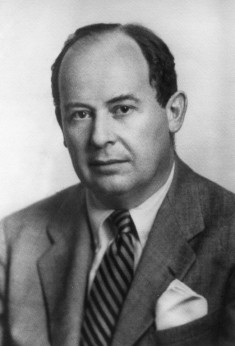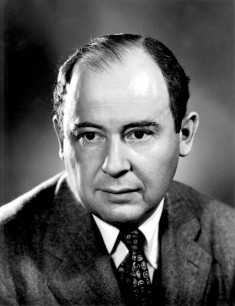John Von Neumann was a famous Hungarian-American mathematician and polymath. He made major contributions in the field of mathematics, physics, and statistics. He was a pioneer of the application of the operator theory to quantum mechanics and he is also a key figure in the development of game theory and the concepts of cellular automata, digital computer, and the universal constructor.
His mathematical analysis of the structure of self-replication helped in the discovery of the DNA structure. During his lifetime, he wrote about 150 published letters; 60 pure mathematics, 60 in applied mathematics, and 20 in physics.
Early Life
John was born on December 28, 1903, in Budapest, Austria-Hungary. He was born into a wealthy Jewish family. He was the eldest of three brothers and his dad was a banker who held a doctorate in law. As a young child, John showed great interest in languages, memorization, and mathematics.
By the time he turned six, he could exchange jokes in Classical Greek, display great mental calculation abilities, and memorize telephone directories. By the time he was eight, he was already familiar with differential and integral calculus.
John joined a German-speaking school in Budapest in 1911. Although his dad insisted that he attend school at the grade level appropriate to his own age, he agreed to hire private tutors that would give his son advanced instruction in the areas in which he excelled.
Educational Years
At 15 years old, he started studying advanced calculus under Gabor Szeqo. When Szeqo first men John, he was so astounded with this young man’s mathematical talent that he cried. He visited John twice a week to tutor him. By the time he was 19, John had published two major mathematical papers. The second paper gave the modern definition of ordinal numbers.
At the age of 22, John received his Ph.D. in mathematics from Pazmany Peter University. He also earned a diploma in chemical engineering from ETH Zurich in Switzerland. This diploma was per his father’s request who wanted his son to work with him in the industry rather than investing too much time in mathematics.
Career Highlights
 Between the years 1926 and 1930, John taught at the University of Berlin. By the end of 1927, he had published 12 major papers in mathematics and by the end of 1929, he had published 32 papers. In 1937, he became a naturalized citizen of the U.S. A few years later, he started working on the Manhattan project. Here he tackled the immense calculations that were required for construction of atomic bomb. He became interested in using machines of the calculation of numbers and resolution of certain mathematical problems.
Between the years 1926 and 1930, John taught at the University of Berlin. By the end of 1927, he had published 12 major papers in mathematics and by the end of 1929, he had published 32 papers. In 1937, he became a naturalized citizen of the U.S. A few years later, he started working on the Manhattan project. Here he tackled the immense calculations that were required for construction of atomic bomb. He became interested in using machines of the calculation of numbers and resolution of certain mathematical problems.
During and also after the war, his interest in computers grew and he even contributed to the construction of the very first modern computer. The work established principles on which today’s computers are based. However, his main focus was on game theory. Game theory was the study of the conflict between two opponents seeking to arrive at two different goals, each trying to beat the other.
Contributions to Mathematics
One of John’s achievements was the rigorous mathematical formulation of quantum mechanics in terms of liners operators on Hilbert spaces. John von Neumann provided a strong foundation for the quantum statistical mechanics and even proposed a proof of all hidden variables. This showed that quantum mechanics was totally different from all previously known theories in physics.
John is often credited with in the contribution of the study of algorithms. He also founded the field of continuous geometry which followed his work on rings of operators.
Personal Life
John Von Neumann was married twice. In 1930, he married Mariette Kovesi just before migrating to the U.S. They had one child. In 1937, the couple divorced and one year later, he married Klara Dan.
John had a wide range of cultural interests; he loved ancient history and was also fluent in Latin and ancient Greek. He was also a social person who enjoyed throwing large parties at his house in Princeton. Despite being a bad driver, he enjoyed driving and was occasionally arrested for causing accidents.
In 1955, he was diagnosed with cancer. One biographer speculated that this illness was caused by his presence at the Bikini nuclear tests in 1946. He died about a year later in Washington, D.C. On his deathbed, he entertained his brother with some word-for-word recitation of a few lines from Goethe’s Faust. He is buried in Princeton, New Jersey.
